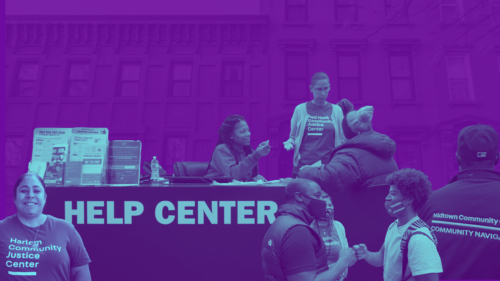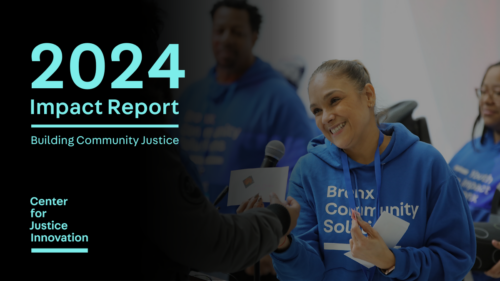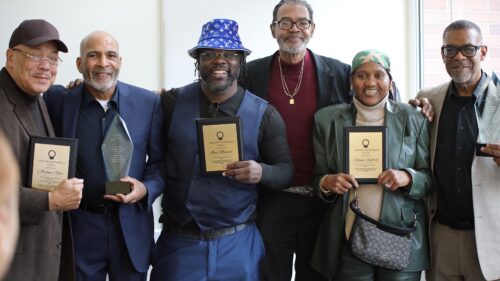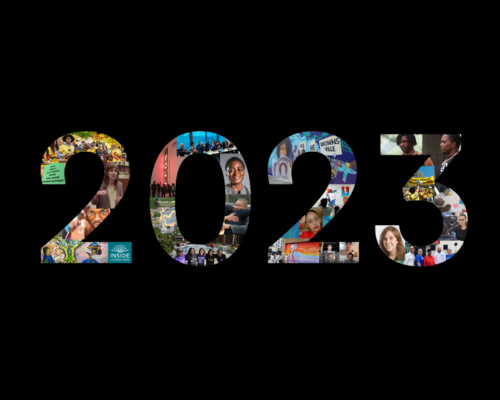Harlem Reentry Court – One Parolee’s Experience
A number of challenges exist for a parolee just leaving prison, and the newfound freedom of a parolee can be overwhelming. The Harlem Community Justice Center helps parolees make the transition from life in prison to responsible citizenship.
About a week before Debra left prison, she learned that she would be part of a new reentry program involving frequent court appearances and participation in a drug treatment program, among other activities. Debra had never heard of parole reentry before. “At first I was really mad,” she says. “I had never done parole in my life, but I knew you weren’t supposed to go to court or in front of a judge. I was really angry that I had to go every week.”
Six months later, she completed the program and had an entirely new perspective: “Putting me in the parole reentry program was the best thing they ever could have done for me and my life,” she says. “I think they should put more people in it. If you’re coming home to do the right thing, it’s the place to be.”
Debra was the first female graduate from the Harlem Reentry Court, which began as a joint pilot project of the New York State Division of Parole, the Division of Criminal Justice Services, and the Center for Court Innovation. Since opening in June of 2001, the court has averaged about 80 new cases each year. Debra’s experience is typical. “Many parolees are resistant at first,” says clinical director John Megaw, “but there’s a huge change by the time they complete the program.”
A number of challenges exist for a parolee just leaving prison. While incarcerated, inmates are told what to do and when to do it, and the newfound freedom of a parolee can be overwhelming. Parolees may have difficulty adjusting to the world at large. “It’s not always a smooth sail,” Megaw says. “People slip into the patterns of behavior that got them into trouble in the first place.”
For those returning to society from long prison sentences, the world can be completely different and require a daunting number of adjustments. “It’s almost like coming back from war,” Megaw says. It is no surprise, then, that a large number of parolees return to prison, especially given the strict set of guidelines they need to follow as conditions of release.
Recent numbers show that two-thirds of parolees return to prison within three years (see Bruce Frederick's Factors Contributing To Recidivism Among Youth Placed With The New York State Division For Youth. Albany, NY: New York State Division of Criminal Justice Services). The Parole Reentry Court in Harlem attempts to address this problem by helping parolees navigate the world outside the prison walls.
For Debra, the program helped her stay focused: constant supervision, a rigid schedule, job training, and a group of people intent on seeing her progress provided a strong web of support. As she describes it:
It gave me a good start in life, it really did. Because I’m still doing good. They sent me to a class when I first came home, where they teach you how to get jobs, and though I got a job on my own, I was glad for the experience they gave me. Eventually I just started enjoying going over there. I was from Harlem, and when they told me they’d help me with any problems that occurred I was already going through a lot of problems. And I had hard things with them and hard times but I needed that. I had a social worker over there, I had my parole officer. At first I really didn’t care about the drug treatment program they sent me to, but I finished it, and I think it’s great. I think it’s the best thing they ever came up with.
Direct relationships—the constant contact and face-to-face meetings—are crucial for keeping a parolee on track. The intense supervision allows the court to intervene as soon as problems appear. One of the basic principles that drives the reentry court is that all actors in the criminal justice system (police, courts, institutional and community corrections) play a role not only in offender processing and control but also in long-term offender change and reintegration into their communities. The more eyes watching the parolee, the more likely he or she will succeed. And criminal justice agencies can’t do it alone—they must engage families, community-based service providers, faith- and community-based organizations, and other sources of formal and informal support in reintegrating offenders.
Judge Brigitte Fortune, who presides over the Harlem Reentry Court, talks about the importance of creating opportunities for the parolees—and constantly paying attention to what works and what doesn’t in each case. This personalized, concentrated attention leaves room for dialogue and negotiation as well. Debra, for example, had a hard time with the drug treatment program, and initially found herself at odds with the judge over it.
I was really having a hard time with this program because they wanted me to quit my job and be an inpatient in the program. They were persistent. I understand that they want you to come to their program, but I was working at the time and it was really important to me because it was a struggle in my household. I was living with my mother; she’s a senior citizen and it was really a struggle for me to go to this program every day. And they weren’t paying my car fare, and that was the only problem I really had with the reentry, was the drug treatment program they sent me to.
Our first confrontation we had, the judge and I, we were going word for word in the court, because she really didn’t understand that my job was really important to me, and she wanted me to stay and go to the program every day or become a resident in the program and she’s telling me, what is more important to you, the program or the job? And I’m telling her, well my job is more important to me. The program is more important for y’all, but I need this job! And we had it out but eventually came to an agreement, where I’d go to program twice a week and work the other days. And then I felt much better.
As Judge Fortune puts it: “The idea is to set up a program that best suits you and that’s going to give you the best chance of succeeding. So it’s intensive, it’s more personalized, it’s flexible, and that to me is the best part of the reentry program. When you have all this focus on you, everyone can see what’s going on, you can get adjustments at any time during your supervision while you’re in the program, to give people that chance to succeed.”






